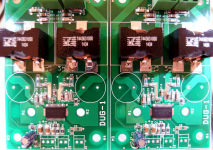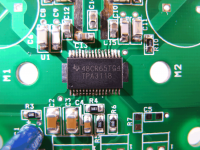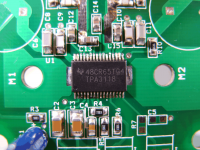One more pair available?
Yes, but tracked package...last time regular mail did not make it to Romania and I resent the order.
I will let you know how much it will be before I send it...pm with shipping address, please.
Last edited:
2 boards nearly complete, does everything seem right ?
I just finished soldering most of the 2 dug boards this afternoon. Can anyone with a sharp eye or keen insight take a quick look and suggest if anything is amiss ?
Cheers everyone and thanks in advance to any comments.
PS. A BIG thanks to DUG for his contributions!
I just finished soldering most of the 2 dug boards this afternoon. Can anyone with a sharp eye or keen insight take a quick look and suggest if anything is amiss ?
Cheers everyone and thanks in advance to any comments.
PS. A BIG thanks to DUG for his contributions!
Attachments
Last edited:
I just finished soldering most of the 2 dug boards this afternoon. Can anyone with a sharp eye or keen insight take a quick look and suggest if anything is amiss ?
Cheers everyone and thanks in advance to any comments.
PS. A BIG thanks to DUG for his contributions!
Looks very good...especially the IC.
Did you manage to get the bottom pad soldered?
I am in for 9 boards (+1 free)...
I will PM you with details.
pm reply.
Looks very good...especially the IC.
Did you manage to get the bottom pad soldered?
I did solder the bottom pad. I flowed some extra solder onto the exposed pad and then soldered one row of the IC's pins, then pushed down on the IC while heating the pad from the reverse side until the IC lined up flush with the PCB, with lots of flux, of course. This was only the 2nd time I tried to solder these reverse-side power pads, so I hope it is fully soldered.
Thanks DUG! I am going to do a few checks before powering them up later today.
Clicking/Popping Sound
Finally got the boards up and running, after being away from this hobby for a while.
I must say, with the stock parts and right at the bat, the DUG board sounded very good. Impressive. However, I get clicking/popping sound when I turn off the power, similar to YJ Blue board. I am using Astron SL 11A as power source. Anybody experiencing the same, whether using this power source or something else? Can I do something about it and eliminate this nuisance?
Looking forward to replacing the inductor with Wurth, and hoping for SQ improvement.
Thanks for any help.
Finally got the boards up and running, after being away from this hobby for a while.
I must say, with the stock parts and right at the bat, the DUG board sounded very good. Impressive. However, I get clicking/popping sound when I turn off the power, similar to YJ Blue board. I am using Astron SL 11A as power source. Anybody experiencing the same, whether using this power source or something else? Can I do something about it and eliminate this nuisance?
Looking forward to replacing the inductor with Wurth, and hoping for SQ improvement.
Thanks for any help.
Finally got the boards up and running, after being away from this hobby for a while.
I must say, with the stock parts and right at the bat, the DUG board sounded very good. Impressive. However, I get clicking/popping sound when I turn off the power, similar to YJ Blue board. I am using Astron SL 11A as power source. Anybody experiencing the same, whether using this power source or something else? Can I do something about it and eliminate this nuisance?
Looking forward to replacing the inductor with Wurth, and hoping for SQ improvement.
Thanks for any help.
I just powered up my boards after thoroughly checking them. They do not pop on turn on, but do pop at turn off. I will eventually be using the mute switch feature (J2, I think) to mute both boards instead of powering them off via power switches. There will be a master power switch at the back of the amp for power, of course. So I do not think the pop thing will be an issue.
Oh and to DUG:
I just gave the boards a quick listen. So far, they sound good. There is no audible hiss from the speakers that I can detect (with the 2 pairs I tried) and the amplifier ICs stay cool to the touch after a few minutes of loud play (I can not detect warmth from them by touching), so I think the TPA3118s' are soldered properly to the board. Thanks again!
How do you wire the mute to get rid of the pop? Does it mean you will have 2 switches? One for power, and another toggle switch connected to the mute?
For now, i just have one switch, and it is from the power supply. Eventually, I will be adding power switch for each board, for trying other power supplies.
For now, i just have one switch, and it is from the power supply. Eventually, I will be adding power switch for each board, for trying other power supplies.
I just powered up my boards after thoroughly checking them. They do not pop on turn on, but do pop at turn off. I will eventually be using the mute switch feature (J2, I think) to mute both boards instead of powering them off via power switches. There will be a master power switch at the back of the amp for power, of course. So I do not think the pop thing will be an issue.
Oh and to DUG:
I just gave the boards a quick listen. So far, they sound good. There is no audible hiss from the speakers that I can detect (with the 2 pairs I tried) and the amplifier ICs stay cool to the touch after a few minutes of loud play (I can not detect warmth from them by touching), so I think the TPA3118s' are soldered properly to the board. Thanks again!
How do you wire the mute to get rid of the pop? Does it mean you will have 2 switches? One for power, and another toggle switch connected to the mute?
For now, i just have one switch, and it is from the power supply. Eventually, I will be adding power switch for each board, for trying other power supplies.
I will have a master power entry switch at the AC inlet at the back of the amplifier. There will also be a double-pole double-throw switch which connects to the two jumpers on the DUG boards, one for each channel (the J2s). This is my mute switch and it will be on the front panel. This switch shuts down the output sections of the amplifier IC when it is pulled low (J2 jumpered or switch equivalent).
According to the white paper on the amplifier IC, they specify: "for the best power-off pop performance, place the amplifier in the shutdown mode prior to removing the power supply." This is exactly what I am going to do. The pop at turn-off isn't severe for my speakers, as my speakers have fairly low sensitivity.
The mute switch sounds like a good idea.
Cross-posted to the Wiener thread, but below is my status. It's all bolted in. Just a few more details to attend to.
BK
Cross-posted to the Wiener thread, but below is my status. It's all bolted in. Just a few more details to attend to.
BK
An externally hosted image should be here but it was not working when we last tested it.
The mute switch sounds like a good idea.
Cross-posted to the Wiener thread, but below is my status. It's all bolted in. Just a few more details to attend to.
BK
An externally hosted image should be here but it was not working when we last tested it.
I've had a few questions by PM, so I will add detail here for all:
- Cases are from siliconray type RE2205 supplied with blank rear panels on request.
- The left unit employs an 18V linear regulated sigma-11 from AMB.org and is DIY with a shielded 50VA Antek transformer. I drilled for eventual dual-mono Wiener cards and left room for input transformers. Wiener cards were made in my own reflow oven!
- The right unit employs a 20V/300W Connexelectronic SMPS300RS.
BK
I've had a few questions by PM, so I will add detail here for all:
- Cases are from siliconray type RE2205 supplied with blank rear panels on request.
- The left unit employs an 18V linear regulated sigma-11 from AMB.org and is DIY with a shielded 50VA Antek transformer. I drilled for eventual dual-mono Wiener cards and left room for input transformers. Wiener cards were made in my own reflow oven!
- The right unit employs a 20V/300W Connexelectronic SMPS300RS.
BK
Thank you!
OK saw it copied again above, TI doesn't refer to mutepin when writing this in datasheet. Mutepin doesn't switch down outputsections tpa. Pulling SDZ low will. Mutepin doesn't prevent power off pop either, SDZ pin will.
I will have a master power entry switch at the AC inlet at the back of the amplifier. There will also be a double-pole double-throw switch which connects to the two jumpers on the DUG boards, one for each channel (the J2s). This is my mute switch and it will be on the front panel. This switch shuts down the output sections of the amplifier IC when it is pulled low (J2 jumpered or switch equivalent).
According to the white paper on the amplifier IC, they specify: "for the best power-off pop performance, place the amplifier in the shutdown mode prior to removing the power supply." This is exactly what I am going to do. The pop at turn-off isn't severe for my speakers, as my speakers have fairly low sensitivity.
OK saw it copied again above, TI doesn't refer to mutepin when writing this in datasheet. Mutepin doesn't switch down outputsections tpa. Pulling SDZ low will. Mutepin doesn't prevent power off pop either, SDZ pin will.
I am going to tinker with this aspect soon. I was thinking that the 2nd pin of the J2 connector is currently tied to ground. There shouldn't be any reason why we couldn't cut the traces around this pin to isolate it from ground and run a fine wire under the board to SDZ or through a resistor (100k) to V+ to pull Mute to SDZ (high) to put the amplifier in mute. Shouldn't be hard, but might be a bit unsightly if you peek under the boards.
It almost seems odd to me that you need to pull Mute to high to actually mute...
- Status
- This old topic is closed. If you want to reopen this topic, contact a moderator using the "Report Post" button.
- Home
- Group Buys
- GB for TPA3116/8 PBTL bare pcb


